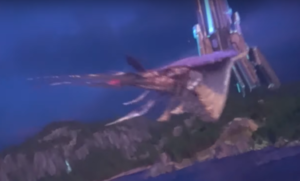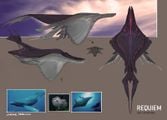Olfmeri: Difference between revisions
From Halopedia, the Halo wiki
(Best we can do for now.) |
|||
| Line 1: | Line 1: | ||
{{Era|Forerunner|Post}} | {{Era|Forerunner|Post}} | ||
[[File:HOD Olfmeri.PNG|thumb|300px|right|Olfmeri on an Halo installation.]] | |||
The '''olfmeri''', colloquially known as the '''sky leviathan''' or the '''space whale''', is an elusive and mysterious [[List of animals|creature]] described as an "avian cetacean", placed on several [[Forerunner]] installations by the [[Lifeworker]]s.<ref name="canonfodder">[https://www.halowaypoint.com/en-us/community/blog-posts/canon-fodder-jurassic-ark '''Halo Waypoint''': ''Canon Fodder - Jurassic Ark'']</ref> | The '''olfmeri''', colloquially known as the '''sky leviathan''' or the '''space whale''', is an elusive and mysterious [[List of animals|creature]] described as an "avian cetacean", placed on several [[Forerunner]] installations by the [[Lifeworker]]s.<ref name="canonfodder">[https://www.halowaypoint.com/en-us/community/blog-posts/canon-fodder-jurassic-ark '''Halo Waypoint''': ''Canon Fodder - Jurassic Ark'']</ref> | ||
Revision as of 09:42, July 8, 2019
The olfmeri, colloquially known as the sky leviathan or the space whale, is an elusive and mysterious creature described as an "avian cetacean", placed on several Forerunner installations by the Lifeworkers.[1]
History
When the Fleet of Retribution arrived at Installation 00 on December 11, 2552, UNSC Forward Unto Dawn captured audio from the installation that inadvertently including the "songs" of an olfmeri pod. Doctor Luther Mann detected the creatures' calls and extensively studied them. A joint UNSC–Swords of Sanghelios task force, including Mann, encountered a pod of olfmeri during a covert mission to Installation 00 in March of 2555. Using his knowledge of the olfmeri's calls, Mann was able to briefly call to one.[2]
Biology
The creatures are large with somewhat-bulbous, teardrop shapes. They have large, toothy mouths that extended across their fronts and about a third of the way down their sides. The creatures' undersides are pure white.[2]
The olfmeri's ability to defy gravity seems almost impossible, given the incredible size and nature of these beasts. A passive species, these leviathans are as large as many species of whale found on Earth and bear striking similarities to the huge aquatic mammals, but with one key difference: while whales on Earth inhabit the planet's oceans, olfmeri are capable of flying through the skies. The biological mechanisms behind their buoyancy is still a mystery to scientists of the Office of Naval Intelligence, though there are no shortage of curious theories.[1]
Behavior
- "The songs don't serve as a language in the same way that words do for us. It conveys feelings, sensations."
- — Doctor Luther Mann[3]
Olfmeri traveled together in pods. The creatures are apparently passive, and show interest in investigating new species. The creatures communicate with each other by "singing" and whistling; these vocalizations are slightly painful to human ears. The olfmeri communicate not as a form of language, but to convey feelings and sensations. Humans have the ability to mimic these vocalizations. During Operation: FAR STORM, Doctor Luther Mann mimicked the calls of a olfmeri and attracted one of the creatures. However, the olfmeri quickly flew off upon realizing that Mann was not a member of its species.[2]
Production notes
The sky leviathan was planned to be featured in Halo 4. It was an enormous flying whale-like creature that would have lived on Requiem. The concept art were drawn by 343 Industries artist Paul Richards.[4][5]
Gallery
List of appearances
- Halo: Hunters in the Dark (First appearance)
- Halo: Outpost Discovery
Sources
- ^ a b Halo Waypoint: Canon Fodder - Jurassic Ark
- ^ a b c Halo: Hunters in the Dark, pages 141-144 (Google Play edition)
- ^ Halo: Hunters in the Dark, page 143 (Google Play edition)
- ^ Autodestruct Digital: Space Whales 1
- ^ Autodestruct Digital: Space Whales 2



